Treasures Of The SMC Part II
Back to Treasures of The SMC Index
By Andrew Murrell
This is Part Two of a series of articles on the SMC. The article has been illustrated by images from the Hubble Digitised Sky Survey.
Lindsay 1
Is a globular cluster, located 2° South West of 47 Tucanae. I have included this cluster in the list even though it is not on the charts, as it easily visible in a 10" telescope. The cluster appears as a 2.5 arc minute hazy patch with no central condensation. The outer edge of the cluster is fairly well defined. The brightest stars in the cluster shine at 14th magnitude so when it is viewed through 16" and larger telescope the cluster should start to resolve. 30 arc minutes North of the cluster is a 7th magnitude star which helps in locating the cluster. |
 |
|
Kron 3
On the Southern outskirts of 47 Tucanae is the Globular Kron 3. This cluster is easily visible through an 8" scope in a lightly polluted sky and may be visible in a 5" scope from a dark sky. It lies between two 10th magnitude stars with a 3rd. magnitude star 3.5 arc minutes to the North East. The surface brightness of the cluster is even across the face with no central condensation. The outer edge of the cluster fades rapidly into the sky background and is fairly well defined. The apparent size of the cluster is 1.5 arc minutes and looks very nice with the crowded background of 47 Tucanae. Large telescopes show a degree of mottling to the cluster but it does not even begin to resolve in the 20".
|
|
|
Kron 7
Is yet another globular cluster in the vicinity of 47 Tucanae, 13 arc minutes East of Kron 3 and 44 arc minutes South of 47 Tucanae. Again this cluster is not marked on the map but I have included it in the list as a challenge to large scope owners. The cluster has a low surface brightness and is 45 arc seconds across. There appears to be no central condensation to the cluster. It may be hard to pick the cluster from the starry background. High power is recommended to see Kron 3 and Kron 7 together.
|
|
|
NGC 121
The Northern edge of 47 Tucanae reveals yet another small globular cluster. Discovered by Sir John Herschel during his observations of the SMC. His initial description for the cluster was "Pretty bright, pretty small, very gradually brighter middle". This description is quite accurate as it is 1.5 arc minutes across and 10.6 magnitude. The central 40 arc seconds is much brighter than the outer environs of the cluster. The cluster is well detached from the background sky. The bright central condensation makes this a challenging target for a 4" telescope. The brightest stars in the cluster are about 15th magnitude but it's compact size makes it difficult to resolve.
|
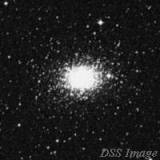 |
|
NGC 152
This cluster looks like a slightly larger and brighter version of Kron 3. It can be located 1° South East of 47 Tucanae .The cluster is 1.5 arc minutes across with no central condensation, and has an integrated magnitude of 12.8. This cluster was also discovered by Herschel with his 18¼" telescope but owners of 6" scopes may glimpse this globular cluster from a dark sky. No central condensation was visible but the brightest stars do start to resolve with larger telescopes. The cluster is well defined from the background sky.
|
 |
|
NGC 176
This open cluster can be found 13 arc minutes East of NGC 152 and 3.5 arc minutes South of a 7th magnitude yellow star. Herschel described the cluster as extremely faint; this is not something that I would agree with The cluster has a bright well defined Nucleus. No size estimates exist in the catalogues but I would put it at 30 arc seconds in diameter. The central 15 seconds is bright while the outer areas of the cluster gradually fade into the sky background. The compact nature of the cluster makes it difficult to resolve individual stars even in a 20" telescope. The bright nucleus of the cluster makes it easily visible in an 8" scope but owners of 6" telescopes may wish to try.
|
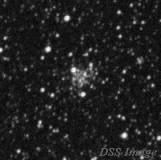 |
|
Kron 21
Is a large open cluster 40 arc minutes North East of NGC 176. It is fairly large being 1.5 arc minutes in diameter with a fairly low surface brightness. A 10' telescope with medium power should show this cluster clearly. No central condensation could be seen and it appears to be not well detached from the background sky. Large telescopes will not resolve the cluster as the brightest stars are below 16th magnitude. The Northern edge of the cluster appears to be flattened along an East-West axis.
|
|
|
NGC 220
This is the first in a group of 3 open clusters that sit right on the Western edge of the SMC star cloud. The cluster is located 25 arc minutes South East of NGC 176. This small cluster is 40 arc seconds in diameter with a condensed nucleus that is quite bright. The total magnitude of the cluster is 11.5. The cluster should be visible in a 6" telescope. In the 20" the stars in the outskirts of the cluster start to resolve and a faint chain of stars becomes visible. This makes the cluster appear oval in shape. A 10th magnitude star lies between NGC 220 and the next cluster in line.
|
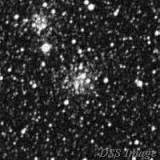 |
|
NGC 222
Is the second cluster in this line of 3. It is the smallest, being about 30 arc seconds in diameter and marginally fainter than NGC 220. The cluster has a small condense nucleus, with an outer edge that fades steadily into the sky background. The cluster should be visible in an 8" scope from a dark sky. The brightest stars are 15th magnitude so the outer areas of the cluster start to resolve. Surrounding this cluster is a scattering of 13th -14th magnitude stars that make this difficult to confirm. Herschel described the cluster as round and very faint, an observation I agree with.
|
 |
|
NGC 231
The last and largest in the small group of clusters. The original description of the object was an "irregular train of stars and nebula". Upon looking at this cluster, though I could only call this partly correct. The cluster is a scattering of mostly 13th and 14th magnitude stars in an irregular shape not well defined from the sky background. The cluster is 1.5 arc minutes across and is located 2 arc minutes North East of NGC 222. The cluster should visible in a 10" telescope and appears well resolved in larger scopes, as the fainter stars become visible. Upon checking the cluster with the UHC and OIII filter I was unable to find any associated nebula. In fact all 3 nebula were free of nebulosity. This group of 3 clusters can be seen in 10" scopes together when viewed at medium to high power. These clusters lie on the Western edge of a fairly bright star cloud.
|
 |
|
NGC 242
Is a very interesting open cluster, 12.5 arc minutes East of NGC 220. This compact cluster is 25 arc seconds in diameter and has a very strong central condensation. It is fairly bright at 12.2 magnitude and should be visible in a 6" telescope. Surrounding the cluster is a scattering of 12th and 13th magnitude stars. Large telescopes may start to resolve the cluster but this scattering of stars makes it difficult to be certain. On the South Eastern edge of the cluster is another compact group of 15th magnitude stars. This second group is SE 3 another open cluster. This cluster should be visible in 12" scopes, and large scopes like my 20" show this double cluster very nicely.
|
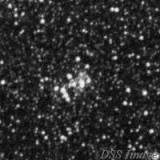 |
|
NGC 248
About 8 arc minutes to the North East of NGC 242 is the open cluster NGC 248. The cluster is 25 arc seconds in diameter with a bright nucleus. The nucleus is 10 arc seconds in diameter and should be visible in a 6" telescope. The brightest members are visible in a 12" scope scattered across the face. A 12" will also reveal an extended halo extending to the North away from the cluster for almost 40 arc seconds. This gives the cluster an almost comet like appearance in the 20" telescope. Several 13th and 14th magnitude stars are also visible in the halo.
When the UHC filter was used to observe this cluster the outer envelope immediately leapt out strongly. The cluster also reacted well to the UHC filter. The nebula complex showed good detail in the 20". A clear division or dark lane could be seen between the cluster and the extended halo. This nebulosity is catalogued as e13. For the really adventurous observer a planetary nebula that belongs to the SMC lies 1 arc minute North of NGC 248. This planetary is about 1-2 arc seconds in diameter so don't expect it to be anything but stellar. The best recommendation I can give the ambitious observer is to use the filter to blink with in front of the eyepiece, which ever star doesn't dim in that area is the planetary.
|
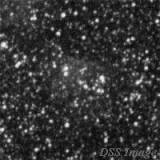 |
|
NGC 256
NGC 256 is one of the most unusual open clusters in this area of the SMC. The first thing you notice is that the cluster appears to be triangular in shape. It is very compact in size at 15 arc seconds across and has a high surface brightness. The total integrated magnitude is 12.2 so it should be visible in a 6" telescope, but to see it's distinctive shape I would recommend a 10" scope. The cluster is located 10 arc minutes South East of NGC 242 with a 10th magnitude star 2 arc minutes North of the cluster. The cluster is homogenous in surface brightness with no appreciable nucleus. The edge of the cluster is sharply defined and resists resolution even in a 20" telescope.
|
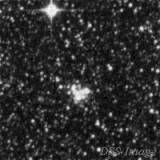 |
|
NGC 265
Is a bright globular cluster 30 arc minutes East North East of NGC 256. The cluster is 1 arc minute in diameter with a slight condensation toward the core, the cluster fades in the outer region gradually in to the sky background. The globular cluster is bright at 11.9 magnitude and is visible in a 6" telescope. This cluster does not appear round as it has a flattened Northern edge. This only seems to appear in lager aperture scopes. Partial resolution was achieved in the 20", so the brightest stars in the cluster should be about 15th magnitude. This is one of the few SMC globulars that looks like a globular.
|
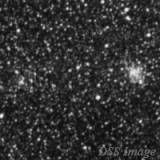 |
|
NGC 269
A complete contrast to the previous globular, NGC 269 can be located just 1 arc minute East South East of NGC 265. This globular is faint and may be difficult for an 8" scope. The small size of the cluster at 25 arc seconds also makes it a difficult object. The cluster shows a minimal condensation toward the centre. 3 arc minutes to the South East is a 10th magnitude star, and some 14th and 15th mag. stars surround the cluster. The cluster though resists all efforts to resolve in the 20" telescope, but a 14th mag. star lies on the North Western edge.
|
 |
|
NGC 267
This cluster lies in a large star cloud in the SMC. The cluster is almost 2 arc minutes in diameter. There is no central condensation, and because it lies in the star cloud, the cluster is harder to pick from the background. The brightest stars should be visible in a 10" scope and appears to be fully resolved in the 20". Herschel's description advised that it included some associated nebula. When a UHC filter was employed the whole field of the eyepiece came to life. The cluster NGC 267 is enshrouded in nebula which appears to extend the object to 6 arc minutes.
|
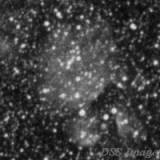 |
Directly to the East is a second separate nebulous area classified as N28. This nebula was fainter in surface brightness than the nebula surrounding the cluster. The Cepheid variable HV 1454 is embedded in the Southern extremity of the nebula. It has a maximum brightness of 11th mag and a minimum of 13th Unfortunately I don t know over what period it varies.
Some 10 arc minutes North is another complex of nebulosity. This time made up from a small round nebula N30 which is quite diffuse and a large oval nebula nearly 8 arc minutes in the long axis. This complex is peppered with 13th to 15th magnitude stars. In larger telescopes the nebula shows a fair bit of detail.
This area of the SMC is quite astounding and deserves some extra attention. 10" to 12" telescopes at low to medium power and armed with a UHC filter should be able to fit the entire complex of nebula into a field of view.
NGC 292
This is the NGC number for the entire galaxy of the SMC. To the naked eyen the SMC is quite a sight. It appears as a small detached part of the milky way. There are 3 easily visible stars surrounding the galaxy. Gamma Tucanae lies 1° directly South of the galaxy and shines at a magnitude 4.1. About 1.5° West of the galaxy lies the second star 47 Tucanae. To the naked eye this globular cluster appears as a 4th magnitude star. To the North West approximately 3° away is Pi Tucanae. Several other stars may be visible naked eye from truly dark skies. To see the galaxy as a whole in a telescope, a wide field is required. If you have access to a scope showing at least a 3° true field, you will be able to fit the main body of the SMC in the eyepiece.
The SMC is very reminiscent of NGC 6822 in Sagittarius when viewed through a 16" or larger telescope. It is an elongated, mottled, and hazy with no central condensation through my 3.5" f/5.8 spotting scope. The South Western end of the galaxy is homogenous with a slightly grainy look toward the centre, possibly due to a number of bright open clusters in that area of the galaxy. Through the spotting scope the North Eastern end of the galaxy shows some brighter patches that correspond to the bright nebulas NGC 346 and NGC 37l. Also dominating this area of the galaxy is the bright globular NGC 362. Like 47 Tucanae, NGC 362 is associated with the Milky Way not the SMC. The South Eastern side of the galaxy also shows some condensed bright patches and this complex corresponds to NGC 456 and NGC 465. The background sky is peppered with 10th to 12th magnitude stars which will be visible to the small 3"- 4" rich-field telescopes.
Whether you view the SMC with the naked eye, binoculars, or a small rich field telescope, the appreciation of seeing fine detail in a galaxy is awe inspiring.
I have included a detailed finder chart and Table Of Objects.
Back to top














